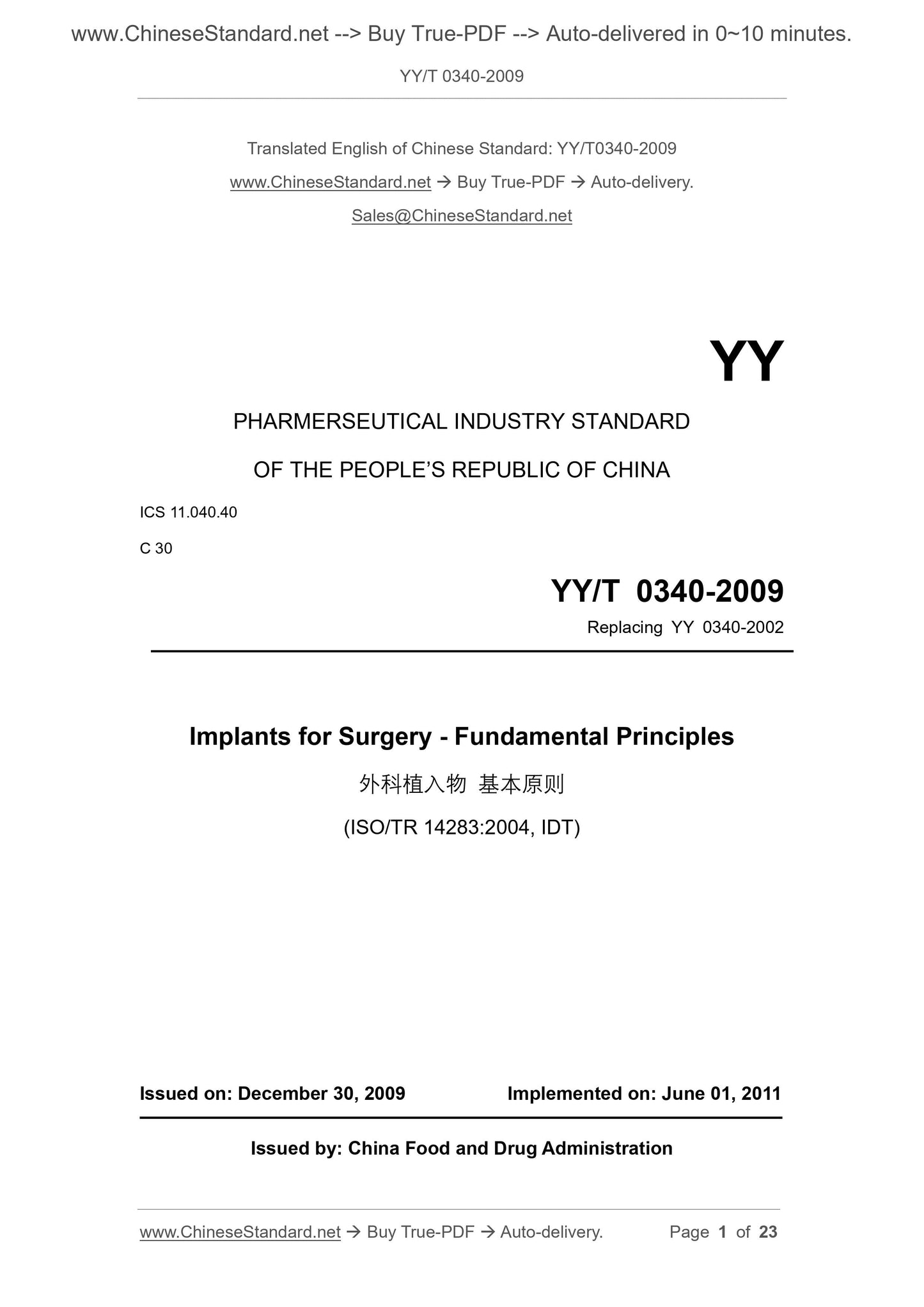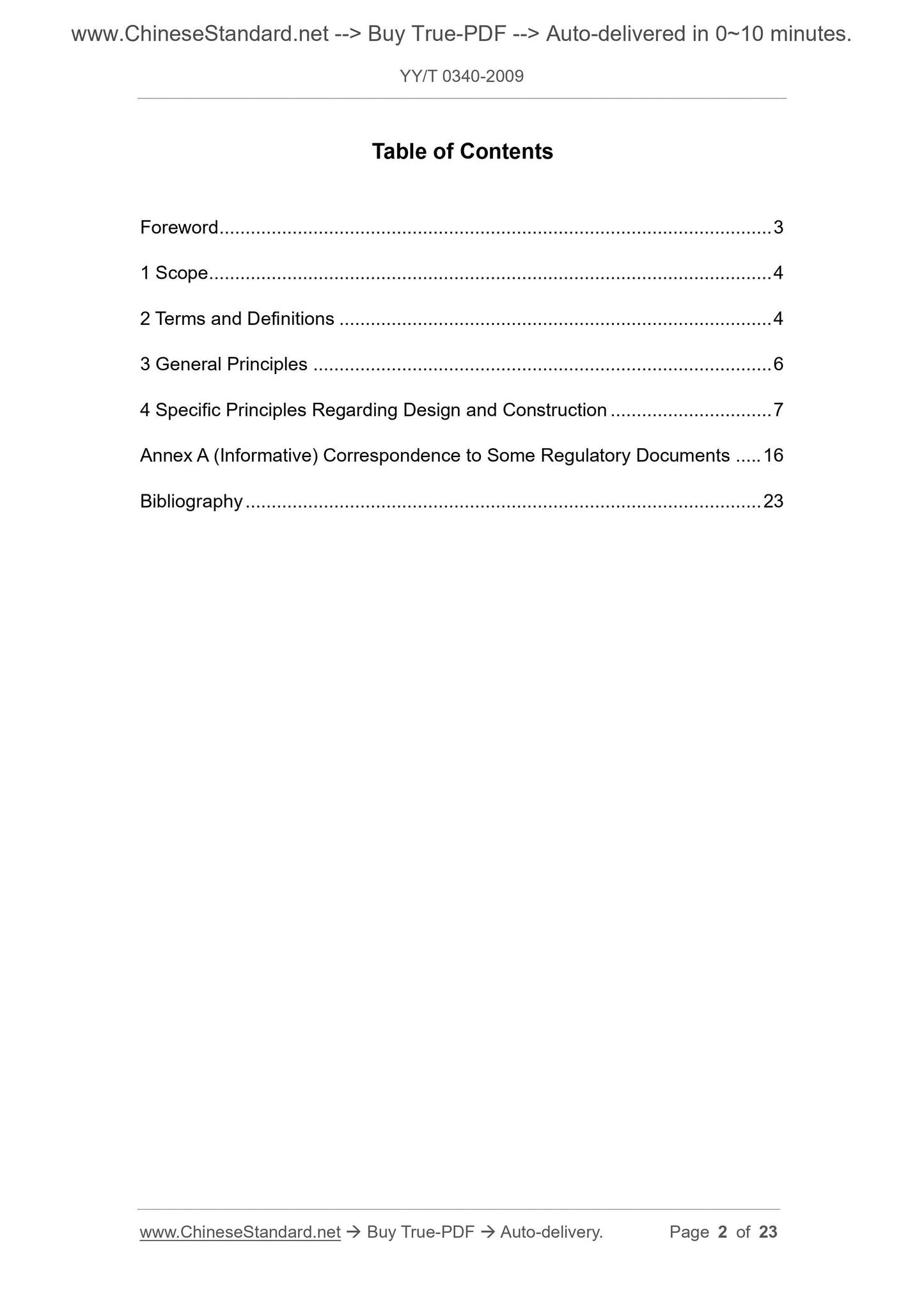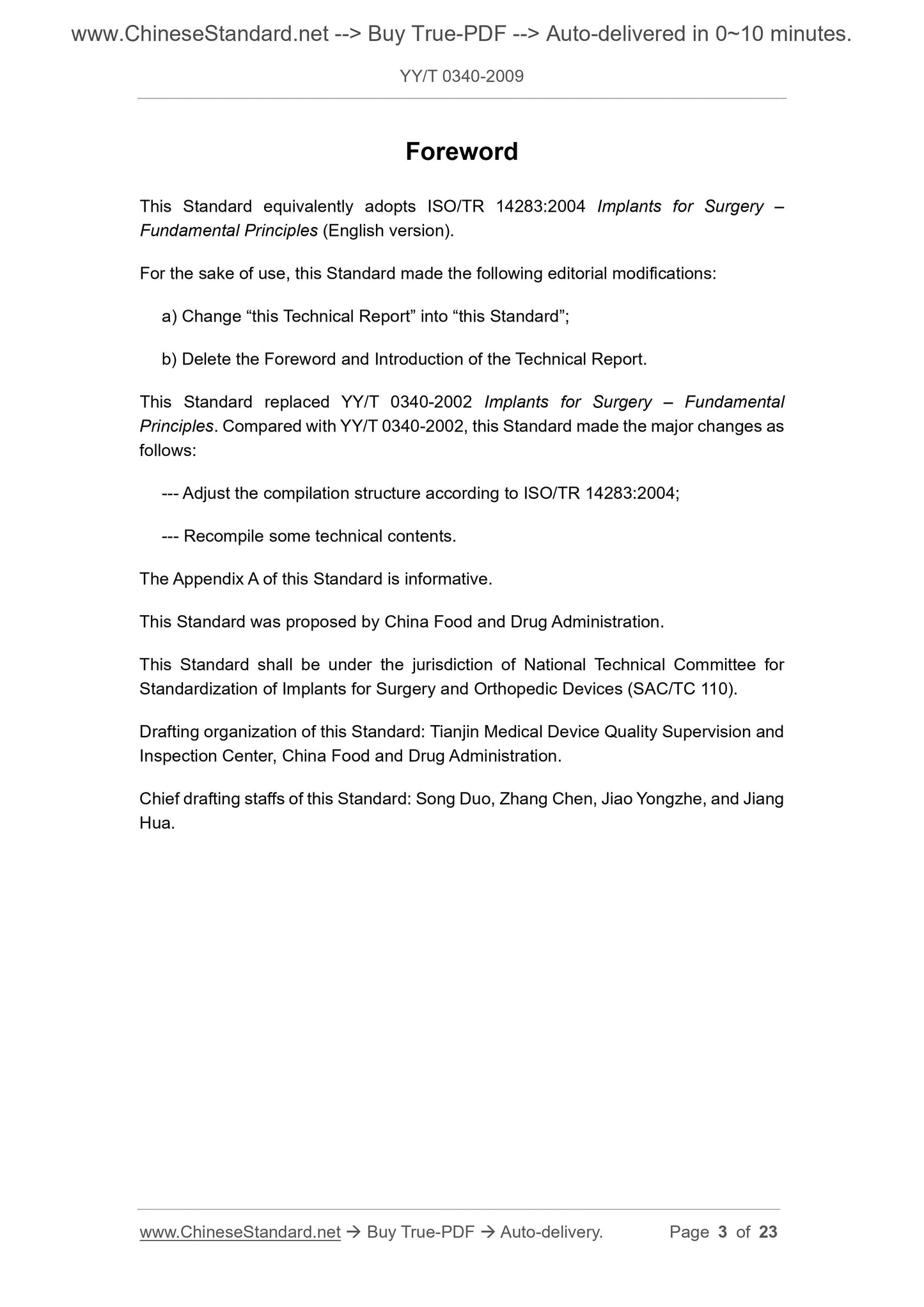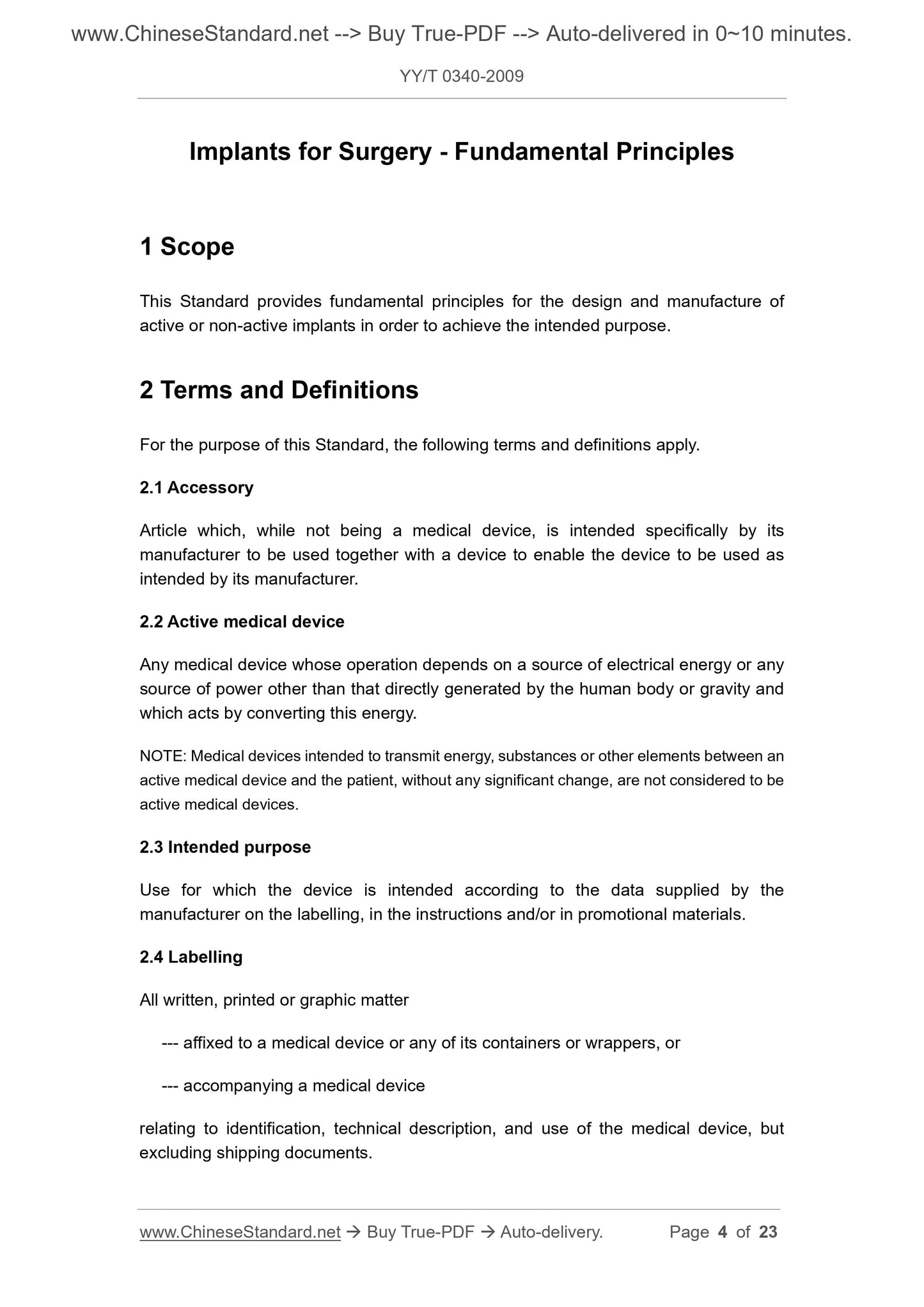1
/
su
4
PayPal, credit cards. Download editable-PDF and invoice in 1 second!
YY/T 0340-2009 English PDF (YYT0340-2009)
YY/T 0340-2009 English PDF (YYT0340-2009)
Prezzo di listino
$220.00 USD
Prezzo di listino
Prezzo scontato
$220.00 USD
Prezzo unitario
/
per
Spese di spedizione calcolate al check-out.
Impossibile caricare la disponibilità di ritiro
Delivery: 3 seconds. Download true-PDF + Invoice.
Get QUOTATION in 1-minute: Click YY/T 0340-2009
Historical versions: YY/T 0340-2009
Preview True-PDF (Reload/Scroll if blank)
YY/T 0340-2009: Implants for surgery. Fundamental principles
YY/T 0340-2009
Implants for surgery.Fundamental principles
ICS 11.040.40
C 30 YY
People's Republic of China Pharmaceutical Industry Standard
Replace YY 0340-2002
Basic principles of surgical implants
2009-12-30 released
2011-06-01 Implementation
Issued by the State Food and Drug Administration
1 Scope
2 Terms and definitions
3 General
4 Special principles concerning design and production...
Appendix A (informative appendix) Relevant regulatory documents
references
Words
This standard is equivalent to ISO /TR U283.20 (M "Basic Principles of Surgical Implants" (English version).
For ease of use, this standard has made the following editorial changes.
a) The term "this technical report" is changed to "this standard";
b) Delete the foreword and introduction of the technical report.
This standard replaces YY/T 0340-2002 "Basic Principles of Surgical Implants", the main changes compared with YY/T 0340-2002
as follows.
-The writing structure was adjusted according to ISO /TR 14283.2004;
-Rewritten some technical content.
Appendix A of this standard is an informative appendix.
This standard was proposed by the State Food and Drug Administration.
This standard is under the jurisdiction of the National Standardization Technical Committee for Surgical Implants and Orthopaedic Devices (SAC/TC 110).
Drafting organization of this standard. Tianjin Medical Device Quality Supervision and Inspection Center of the State Food and Drug Administration.
The main drafters of this standard. Song Duo, Zhang Chen, Jiao Yongzhe, Jiang Hua.
Basic principles of surgical implants
1 Scope
This standard provides the basic principles for the design and manufacture of active or passive implants to achieve the intended purpose.
2 Terms and definitions
The terms and definitions in column F apply to this standard.
2.J.
Accessory
Not a medical device, but specifically designated by its manufacturer to be used in conjunction with a device to enable the use of the device
Items that achieve the intended purpose of the manufacturer.
2.2
Active medical device
Any medical device that relies on electricity or other energy sources instead of energy directly generated or transformed by the human body or gravity to perform its functions.
Note. Medical devices that transfer energy, substances or other elements between active medical devices and patients without any significant changes are not considered active medical devices.
2.3
Intended purpose
The intended use of the device provided by the manufacturer in the label, instructions and/or promotional materials.
2.4
Labelling
All written, printed or graphical objects
-The label is attached to the medical device or its box or packaging, or
-Supplied with medical equipment
Information about the identification, technical description and use instructions of medical devices, but does not include shipping documents.
Note. Some national or regional regulations regard "label" as "information provided by the manufacturer". [ISO 13485..2003]
2.5
Manufacturer
Manufacturer refers to the natural or legal person responsible for the design, manufacture, packaging and labeling of the device in his own name before entering the market, regardless of this
Whether the operator is himself or a third-party representative.
2.6
Medical device
The manufacturer’s intended use is for human use for the following purposes, whether used alone or in combination, including the use of required software
Any instruments, equipment, utensils, materials or other items of which the purpose is.
-Diagnosis, prevention, monitoring, treatment or alleviation of diseases;
-Diagnosis, monitoring, treatment, alleviation or compensation of disability;
-The study, replacement or regulation of anatomical or physiological processes.
Its main expected effect on the human body surface or in the body is not obtained by pharmacological, immunological or metabolic means, but it may have these effects.
The segment participates and plays a certain supporting role.
Note. ISO 13485.2003 is used for modification.
2.7
Medicinal product
For the purpose of medical diagnosis, to treat or prevent human or animal diseases, or to repair, correct, or adjust the physiological functions of humans or animals
A capable substance or combination of substances.
3 General
3- 1 The design and manufacture of implants should follow the following principles. If the implant is used, any accompanying risks and patient benefits can be weighed.
Acceptable, and can achieve a high level of health and safety protection, they should not endanger the patient under the intended use conditions and when used for the intended purpose
The clinical condition or safety of the product should not endanger the safety and health of users and others (where applicable).
3.2 The method used by the manufacturer for the design and production of the implant should follow the principle of safety, and consider the use of widely recognized process methods.
In order to choose the most suitable method, the manufacturer should follow the following principles.
a) Eliminate or reduce risks as much as possible (safety design and production);
b) Where appropriate, adequate protective measures shall be adopted for the risks involved that cannot be eliminated, and protective measures including alarms may be adopted when necessary;
c) Users should be notified of potential risks caused by the shortcomings of the protective measures used.
3.3 The implant should achieve the performance expected by the manufacturer, and its design, manufacturing and packaging should be adapted to the manufacturer’s requirements mentioned in 3.1.
One or more functions.
3.4 During the life specified by the manufacturer, when the implant is stressed under normal use conditions, its characteristics and performance should still comply with 3.1,
The provisions of 3.2 and 3.3 should not adversely affect the clinical environment, the safety of patients and others.
3.5 Taking into account the instructions and information provided by the manufacturer, the design, manufacturing and packaging of the implant should ensure that the implant is not treated during transportation and storage.
It is expected that the characteristics and performance during use will have a negative impact.
3.6 Considering the expected performance, an acceptable risk should be established for any undesired side effects.
4 Special principles related to design and production
4.1 Chemical, physical and biological properties
4- 1.1 The design and construction of the implant should ensure the features and performance mentioned in Chapter 3 "General Rules". Special attention should be paid to. a) the materials used,
In particular, its toxicity should be considered, and its flammability should also be considered where appropriate;
b) Considering the intended purpose of the implant, the compatibility of its materials with biological tissues, cells and body fluids.
4.1.2 Taking into account the intended purpose of the product, the design, manufacturing and packaging of planters should minimize pollution and residues that affect transportation and storage.
The hazards of personnel and patients involved in storage and use of implants. Particular attention should be paid to the exposed organization and the duration and frequency of exposure.
4.1.3 The design and manufacture of the implant should ensure that the implant is in contact with the materials, substances and gases during normal use or normal operation.
Security. If the planter expects to be used in treatment ...
Get QUOTATION in 1-minute: Click YY/T 0340-2009
Historical versions: YY/T 0340-2009
Preview True-PDF (Reload/Scroll if blank)
YY/T 0340-2009: Implants for surgery. Fundamental principles
YY/T 0340-2009
Implants for surgery.Fundamental principles
ICS 11.040.40
C 30 YY
People's Republic of China Pharmaceutical Industry Standard
Replace YY 0340-2002
Basic principles of surgical implants
2009-12-30 released
2011-06-01 Implementation
Issued by the State Food and Drug Administration
1 Scope
2 Terms and definitions
3 General
4 Special principles concerning design and production...
Appendix A (informative appendix) Relevant regulatory documents
references
Words
This standard is equivalent to ISO /TR U283.20 (M "Basic Principles of Surgical Implants" (English version).
For ease of use, this standard has made the following editorial changes.
a) The term "this technical report" is changed to "this standard";
b) Delete the foreword and introduction of the technical report.
This standard replaces YY/T 0340-2002 "Basic Principles of Surgical Implants", the main changes compared with YY/T 0340-2002
as follows.
-The writing structure was adjusted according to ISO /TR 14283.2004;
-Rewritten some technical content.
Appendix A of this standard is an informative appendix.
This standard was proposed by the State Food and Drug Administration.
This standard is under the jurisdiction of the National Standardization Technical Committee for Surgical Implants and Orthopaedic Devices (SAC/TC 110).
Drafting organization of this standard. Tianjin Medical Device Quality Supervision and Inspection Center of the State Food and Drug Administration.
The main drafters of this standard. Song Duo, Zhang Chen, Jiao Yongzhe, Jiang Hua.
Basic principles of surgical implants
1 Scope
This standard provides the basic principles for the design and manufacture of active or passive implants to achieve the intended purpose.
2 Terms and definitions
The terms and definitions in column F apply to this standard.
2.J.
Accessory
Not a medical device, but specifically designated by its manufacturer to be used in conjunction with a device to enable the use of the device
Items that achieve the intended purpose of the manufacturer.
2.2
Active medical device
Any medical device that relies on electricity or other energy sources instead of energy directly generated or transformed by the human body or gravity to perform its functions.
Note. Medical devices that transfer energy, substances or other elements between active medical devices and patients without any significant changes are not considered active medical devices.
2.3
Intended purpose
The intended use of the device provided by the manufacturer in the label, instructions and/or promotional materials.
2.4
Labelling
All written, printed or graphical objects
-The label is attached to the medical device or its box or packaging, or
-Supplied with medical equipment
Information about the identification, technical description and use instructions of medical devices, but does not include shipping documents.
Note. Some national or regional regulations regard "label" as "information provided by the manufacturer". [ISO 13485..2003]
2.5
Manufacturer
Manufacturer refers to the natural or legal person responsible for the design, manufacture, packaging and labeling of the device in his own name before entering the market, regardless of this
Whether the operator is himself or a third-party representative.
2.6
Medical device
The manufacturer’s intended use is for human use for the following purposes, whether used alone or in combination, including the use of required software
Any instruments, equipment, utensils, materials or other items of which the purpose is.
-Diagnosis, prevention, monitoring, treatment or alleviation of diseases;
-Diagnosis, monitoring, treatment, alleviation or compensation of disability;
-The study, replacement or regulation of anatomical or physiological processes.
Its main expected effect on the human body surface or in the body is not obtained by pharmacological, immunological or metabolic means, but it may have these effects.
The segment participates and plays a certain supporting role.
Note. ISO 13485.2003 is used for modification.
2.7
Medicinal product
For the purpose of medical diagnosis, to treat or prevent human or animal diseases, or to repair, correct, or adjust the physiological functions of humans or animals
A capable substance or combination of substances.
3 General
3- 1 The design and manufacture of implants should follow the following principles. If the implant is used, any accompanying risks and patient benefits can be weighed.
Acceptable, and can achieve a high level of health and safety protection, they should not endanger the patient under the intended use conditions and when used for the intended purpose
The clinical condition or safety of the product should not endanger the safety and health of users and others (where applicable).
3.2 The method used by the manufacturer for the design and production of the implant should follow the principle of safety, and consider the use of widely recognized process methods.
In order to choose the most suitable method, the manufacturer should follow the following principles.
a) Eliminate or reduce risks as much as possible (safety design and production);
b) Where appropriate, adequate protective measures shall be adopted for the risks involved that cannot be eliminated, and protective measures including alarms may be adopted when necessary;
c) Users should be notified of potential risks caused by the shortcomings of the protective measures used.
3.3 The implant should achieve the performance expected by the manufacturer, and its design, manufacturing and packaging should be adapted to the manufacturer’s requirements mentioned in 3.1.
One or more functions.
3.4 During the life specified by the manufacturer, when the implant is stressed under normal use conditions, its characteristics and performance should still comply with 3.1,
The provisions of 3.2 and 3.3 should not adversely affect the clinical environment, the safety of patients and others.
3.5 Taking into account the instructions and information provided by the manufacturer, the design, manufacturing and packaging of the implant should ensure that the implant is not treated during transportation and storage.
It is expected that the characteristics and performance during use will have a negative impact.
3.6 Considering the expected performance, an acceptable risk should be established for any undesired side effects.
4 Special principles related to design and production
4.1 Chemical, physical and biological properties
4- 1.1 The design and construction of the implant should ensure the features and performance mentioned in Chapter 3 "General Rules". Special attention should be paid to. a) the materials used,
In particular, its toxicity should be considered, and its flammability should also be considered where appropriate;
b) Considering the intended purpose of the implant, the compatibility of its materials with biological tissues, cells and body fluids.
4.1.2 Taking into account the intended purpose of the product, the design, manufacturing and packaging of planters should minimize pollution and residues that affect transportation and storage.
The hazards of personnel and patients involved in storage and use of implants. Particular attention should be paid to the exposed organization and the duration and frequency of exposure.
4.1.3 The design and manufacture of the implant should ensure that the implant is in contact with the materials, substances and gases during normal use or normal operation.
Security. If the planter expects to be used in treatment ...
Share








